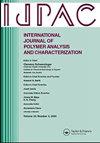生物膜抵抗聚氨酯连接聚(甲氧基乙基丙烯酸酯)共聚物膜增强耐久性和自愈能力
IF 1.6
4区 工程技术
Q4 POLYMER SCIENCE
International Journal of Polymer Analysis and Characterization
Pub Date : 2025-06-06
DOI:10.1080/1023666X.2025.2496301
引用次数: 0
摘要
2-甲氧基乙基丙烯酸酯因其特殊的生物膜抗性特性而引起了人们的极大兴趣,但它与其他单体的相互作用使聚合过程中的结果预测复杂化。为了研究这些机制,我们利用自由基聚合(FRP)合成了抗生物膜预聚物HMEA和GMEA。通过引入苯乙烯间隔剂,缓解了分子内交联引起的凝胶化问题,产生了一组新的预聚物,hsma和gsma。在双酸二丁基锡(DTBDL)催化剂的存在下,与脂肪族异氰酸酯(HDI)交联成功地形成了聚氨酯键,并通过衰减全反射傅立叶变换红外(FTIR)光谱和差示扫描量热(DSC)分析证实了这一点。总的来说,这种交联显著减少了暴露的OH基团,增强了聚合物的疏水性。cGMEA和cgsma均表现出对牛血清白蛋白(BSA)的抗性。力学试验表明,其抗拉强度分别为4.1 MPa和3.6 MPa,延伸率分别为223%和425%。本研究报告了一种基于2-甲氧基乙基丙烯酸酯的聚合物,该聚合物由可逆的聚氨酯键组成,具有自修复能力和增强的耐用性,可作为涂层材料。然而,进一步研究这些协同效应的潜在机制对于充分利用丙烯酸甲氧基乙酯基聚合物的潜力至关重要。本文章由计算机程序翻译,如有差异,请以英文原文为准。
Biofilm-resistant urethane-linked poly(methoxyethyl acrylate) copolymer films with enhanced durability and self-healing capabilities
2-Methoxyethyl acrylate draws significant interest for its exceptional biofilm-resistant properties, but its interaction with other monomers complicates outcome predictions during polymerization. To investigate these mechanisms, we synthesized biofilm-resistant prepolymers, HMEA and GMEA, using free radical polymerization (FRP). Gelation issues caused by the intramolecular crosslinking were mitigated by introducing styrene spacers, yielding a new set of additional prepolymers, HSMEA and GSMEA. Crosslinking with an aliphatic isocyanate (HDI) in the presence of a dibutyltin dilaurate (DTBDL) catalyst successfully formed urethane linkages, which were confirmed by attenuated total reflectance fourier transform infrared (FTIR) spectroscopy and differential scanning calorimetry (DSC) analysis. Overall, this crosslinking significantly reduced the exposed OH groups and enhanced the hydrophobicity of the polymers. Both cGMEA and cGSMEA displayed exceptional antibiofouling behavior as demonstrated by their resistance to bovine serum albumin (BSA). Mechanical tests demonstrated superior properties with tensile strengths of 4.1 MPa and 3.6 MPa and impressive elongation strains of 223% and 425%, respectively. This work reports one of its kind 2-Methoxyethyl acrylate-based polymer consisting of reversible urethane bonds providing self-healing capabilities and enhanced durability as a coating material. However, further investigation into the underlying mechanisms of these synergistic effects will be critical to fully harness the potential of methoxyethyl acrylate-based polymers.
求助全文
通过发布文献求助,成功后即可免费获取论文全文。
去求助
来源期刊
CiteScore
3.50
自引率
5.30%
发文量
37
审稿时长
1.6 months
期刊介绍:
The scope of the journal is to publish original contributions and reviews on studies, methodologies, instrumentation, and applications involving the analysis and characterization of polymers and polymeric-based materials, including synthetic polymers, blends, composites, fibers, coatings, supramolecular structures, polysaccharides, and biopolymers. The Journal will accept papers and review articles on the following topics and research areas involving fundamental and applied studies of polymer analysis and characterization:
Characterization and analysis of new and existing polymers and polymeric-based materials.
Design and evaluation of analytical instrumentation and physical testing equipment.
Determination of molecular weight, size, conformation, branching, cross-linking, chemical structure, and sequence distribution.
Using separation, spectroscopic, and scattering techniques.
Surface characterization of polymeric materials.
Measurement of solution and bulk properties and behavior of polymers.
Studies involving structure-property-processing relationships, and polymer aging.
Analysis of oligomeric materials.
Analysis of polymer additives and decomposition products.

 求助内容:
求助内容: 应助结果提醒方式:
应助结果提醒方式:


